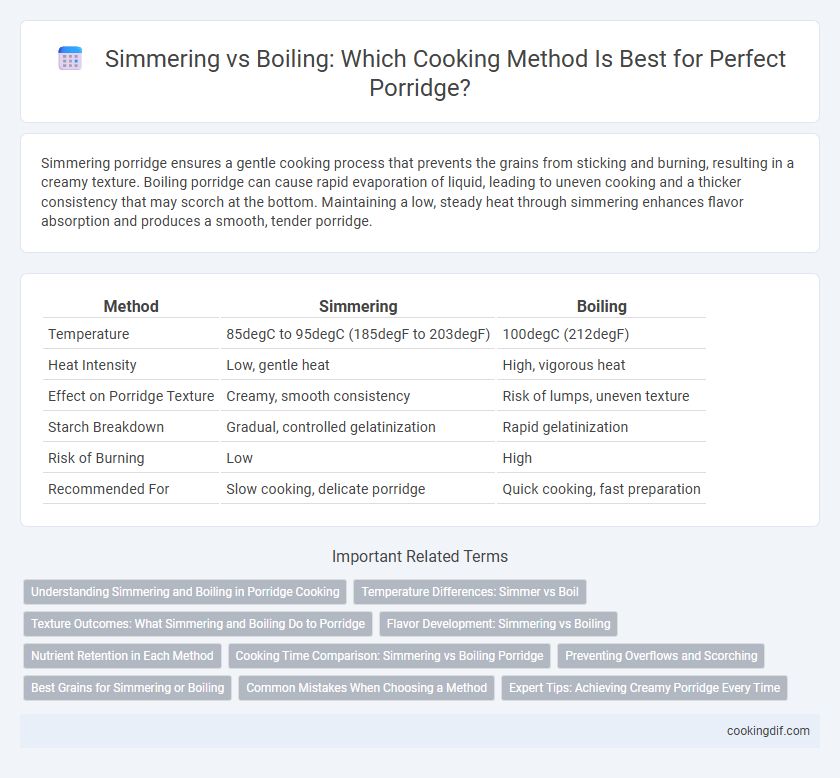Simmering porridge ensures a gentle cooking process that prevents the grains from sticking and burning, resulting in a creamy texture. Boiling porridge can cause rapid evaporation of liquid, leading to uneven cooking and a thicker consistency that may scorch at the bottom. Maintaining a low, steady heat through simmering enhances flavor absorption and produces a smooth, tender porridge.
Table of Comparison
| Method | Simmering | Boiling |
|---|---|---|
| Temperature | 85degC to 95degC (185degF to 203degF) | 100degC (212degF) |
| Heat Intensity | Low, gentle heat | High, vigorous heat |
| Effect on Porridge Texture | Creamy, smooth consistency | Risk of lumps, uneven texture |
| Starch Breakdown | Gradual, controlled gelatinization | Rapid gelatinization |
| Risk of Burning | Low | High |
| Recommended For | Slow cooking, delicate porridge | Quick cooking, fast preparation |
Understanding Simmering and Boiling in Porridge Cooking
Simmering porridge involves cooking at a temperature just below boiling, typically around 185-200degF (85-93degC), which allows gentle, consistent heat to break down the grains without burning. Boiling occurs at 212degF (100degC) and causes rapid bubbles, which can lead to uneven cooking and sticking at the bottom of the pot. Mastering simmering ensures a creamy texture and prevents overcooking, making it the preferred method for preparing smooth, well-cooked porridge.
Temperature Differences: Simmer vs Boil
Simmering porridge involves maintaining a temperature just below boiling point, around 185degF to 205degF (85degC to 96degC), ensuring gentle cooking without breaking down the grains too quickly. Boiling occurs at 212degF (100degC), causing vigorous bubbling that can lead to uneven cooking and potential burning at the bottom of the pot. Controlling temperature differences by simmering preserves the porridge's creamy texture and prevents scorching, optimizing flavor and consistency.
Texture Outcomes: What Simmering and Boiling Do to Porridge
Simmering porridge produces a creamy, smooth texture by gently breaking down starches, allowing for even thickening without clumping. Boiling porridge rapidly agitates the grains, causing uneven cooking and a grainy, sometimes lumpy consistency. Controlled simmering enhances the porridge's softness and mouthfeel, whereas boiling risks overcooking and textural irregularities.
Flavor Development: Simmering vs Boiling
Simmering porridge allows gentle heat to penetrate the grains, promoting the Maillard reaction and slow starch breakdown, which enhances its natural sweetness and depth of flavor. Boiling, by contrast, uses higher temperatures that can cause rapid starch gelatinization but often results in a blander taste due to less time for flavor compounds to develop. Controlling heat through simmering is key for achieving a creamy texture and richer, more complex flavor profiles in porridge.
Nutrient Retention in Each Method
Simmering porridge allows gentle heat that preserves water-soluble vitamins like B-complex and C better than boiling, which can cause nutrient leaching. Boiling at high temperatures often leads to the breakdown of heat-sensitive nutrients and minerals lost in cooking water. Choosing simmering helps retain more antioxidants and enhances the nutritional quality of the porridge.
Cooking Time Comparison: Simmering vs Boiling Porridge
Simmering porridge typically requires 15 to 25 minutes, allowing grains to soften gradually and absorb liquid evenly, resulting in a creamier texture. Boiling porridge reduces cooking time to about 5 to 10 minutes, but rapid boiling can cause uneven cooking and a gritty texture. Choosing simmering over boiling enhances flavor development and produces a smoother, more consistent porridge.
Preventing Overflows and Scorching
Simmering porridge at a low, steady temperature prevents rapid bubbling that causes overflows, maintaining a cleaner cooking surface and reducing messy spills. This gentle heat minimizes scorching by allowing the starches to cook evenly without sticking to the pot's base. Boiling, on the other hand, increases the risk of both overflows and burnt porridge due to vigorous agitation and higher heat.
Best Grains for Simmering or Boiling
Simmering is ideal for delicate grains like oatmeal and quinoa, allowing them to cook slowly and absorb liquid without breaking apart, resulting in a creamy texture. Boiling suits heartier grains such as barley and rice, as the vigorous heat helps soften tougher kernels more quickly but requires careful monitoring to prevent overcooking. Optimal grain selection depends on the desired porridge consistency and cooking time, with simmering enhancing flavor development in softer grains and boiling providing efficiency for denser varieties.
Common Mistakes When Choosing a Method
Simmering porridge ensures even cooking and prevents burning, whereas boiling often causes uneven texture and stickiness due to high heat. A common mistake is maintaining a rolling boil, which breaks down grains excessively and leads to a mushy consistency. Choosing the simmering method preserves nutritional value and achieves the desired creamy texture preferred in quality porridge preparation.
Expert Tips: Achieving Creamy Porridge Every Time
Simmering porridge instead of boiling ensures a gentle heat that prevents the grains from breaking down too quickly, resulting in a creamier texture. Maintaining a low, consistent temperature allows the starches to release gradually, enhancing the porridge's smoothness and preventing lumps. Expert chefs recommend stirring frequently during simmering to evenly distribute heat and achieve perfect creaminess every time.
Simmering vs boiling for method Infographic

 cookingdif.com
cookingdif.com